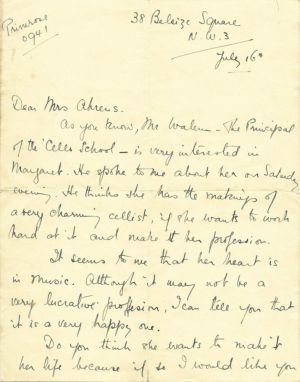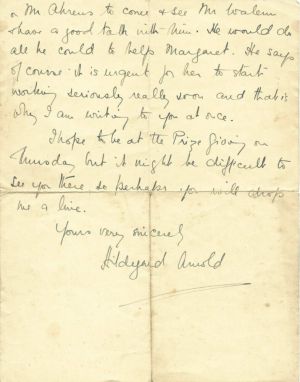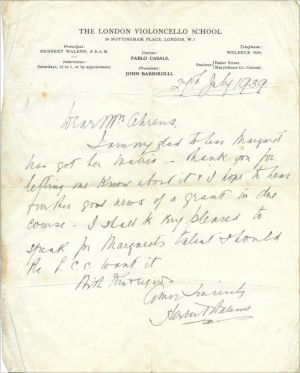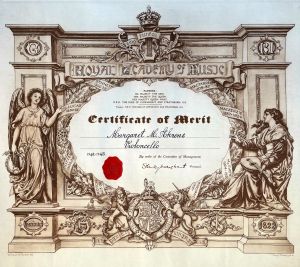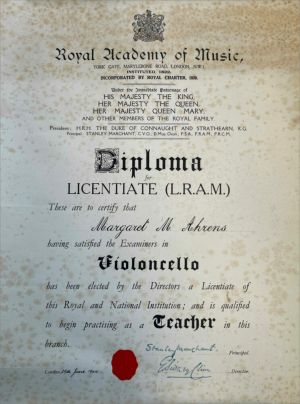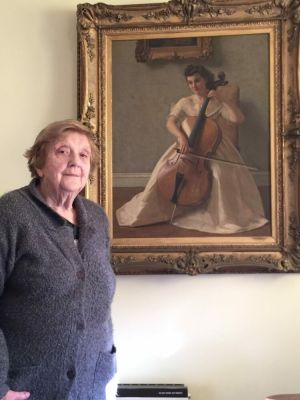Exhibition
Margaret Allan, Herbert Walenn and the London Violoncello School
January 2024
Margaret Allan, cellist, died on 21 June 2023 aged 100 years and 10 days. This interview, recounted by fellow cellist Adrian Bradbury, took place on 22 December 2016 at her home in Bridport.
* * * * *
“You’re performing a Piatti operatic fantasy? My! You’ll need some joie-de-vivre to pull that off!”
So spoke a twinkly-eyed lady holding a cup of tea backstage at the Burton Bradstock Festival in the summer of 2016. This was our first encounter, but it was clear that such words could only come from the mouth of a fellow cellist, and so it was I found myself talking to the wonderful Margaret Allan (née Ahrens), student at the Royal Academy of Music (RAM) from 1939-47.
Margaret was quick to share not just her age – an unguessable 93 – but also some fascinating cello insights and memories which, it soon became evident, deserved a wider audience. I was particularly hooked by the mention of her teacher Herbert Walenn (1870-1953) and his London Violoncello School because Walenn had also taught my boyhood teacher Lilly Phillips and her husband Douglas Cameron who in turn taught my RAM teacher David Strange. Lilly used to mention Walenn but as a teenager I wasn’t exactly curious about London’s cello dynasty so never dreamt of asking the questions that have bugged me since – what exactly was the London Violoncello School, what sort of teacher was Walenn, what was the connection between the London Violoncello School and the RAM?
Margaret kindly agreed to address my curiosity with an interview at her home in Bridport. A stream of enchanting vignettes ensued that chronicled her development as a cellist – a determined young player at a London state school with a talent that was spotted and nurtured by Walenn first at the Cello School and then, on the outbreak of War, at the RAM, graduation from which led to marriage and a distinguished 50-year teaching career that continues to this day.
And the vivid picture she painted brought to life the constant influence of Pablo Casals on the education of cellists from 1919 onwards, the year he encouraged Walenn to found the London Violoncello School (and Cortot the Ecole Normale de Musique de Paris). Through Walenn in London and Alexanian in Paris Casals sought to advance the world of cello technique which he lamented had seen no real progress since Duport’s Method of 1805.
Here is an edited transcript of the interview, which I hope conveys (even without the endless supply of coffee and Dorset biscuits) the joy and hospitality of a morning in the company of a cellist devoted to carrying forth the teaching of Casals’ teaching ambassador in London, Herbert Walenn.
Tell me about your early life and how you came to start learning the cello
“I was born in 1923 to quite poor people – my father was a carpenter who made artificial limbs, and then limbs went metal so he found himself out of work. Both parents were musical – my mother loved to whistle and sing, and was very fond of country dancing, she very much admired Cecil Sharp. My father was a church musician, a singer, and he knew plainsong. We lived in Brook Green near Hammersmith, next to St Paul’s Girls School.
My parents had a lot to do with the school boarding house, called Bute House – my mother had cooked there and my father did carpentry for them – and my sister and I spent all the Summer holidays playing in the grounds. Of course the Head of Music at St Paul’s Girls School was Gustav Holst, and his house more or less backed onto the garden of our house so we knew them well, though more as neighbours walking around Brook Green and saying hello than as musicians. Imogen, Gustav’s daughter, nicknamed my sister Pippety Pip because she was born on January 6th, Epiphany Pip!
I started at Fulham County Secondary School, Munster Road aged 10. One day a lady called Hildegard Arnold came and played her cello to us. I can’t remember exactly what she played – it was just a silly little piece with singing and playing and piggy snorts – but I was terribly impressed. She said at the end “Would anybody like to learn?” and I thought “Gosh yes, I would!” And that was the beginning. My parents were a bit doubtful at first, but I showed commitment by saying I’d walk to school and back every day to save my halfpenny bus money and put it towards cello lessons. My sister was a year older and was already playing flute, but she never wanted to play it to other people, whereas I was dying to play to them!
Hildegard Arnold would take us pupils every year to take part in little concerts at the house of Herbert Walenn, her teacher. It was after one of these concerts, when I had reached the age of 15, that Walenn wrote to my mother and said “if Margaret would like to be a cellist I think she should start now”. That’s how I began learning with Herbert Walenn.”
Where was Walenn’s house and what was it like inside?
“His house was called the London Violoncello School, the address was 34 Nottingham Place, very close to the Royal Academy of Music on the opposite side of the Marylebone Road. Everyone was always shuttling between the Academy and the Cello School. There was a brass plaque outside the front door which was always on the latch. When you went in there was a reception room where you sat and waited for your lesson, there was no housekeeper, you wouldn’t see anyone. As you walked along the hall you passed his office, and then went through to a snuggery, a little room where he would entertain you to tea. And then you would go up this rather nice grand staircase and head towards a rear extension in the back garden. You went along a passage between the two buildings and it was lined with music and files, a 25-foot stretch of corridor shelved from floor to ceiling, an enormous library where you could find any study, any concerto, any sonata. That led into his music salon, a big room with a low-ish platform and piano at one end. He taught in the middle of the room, a space that was filled with chairs on the occasion of a concert. This was the first floor of the rear extension. Then you could go up and there was a smaller recital room where students would show off their abilities to parents and anybody interested! And next to that another room, possibly a guest bedroom, where I’d hear Barbirolli doing his practice. And then another floor upstairs where Walenn must have lived. His sister lived with him in the basement, she was a small timid mousey little person and she taught violin at St Paul’s Girls’. She got me in to play quartets with her pupils in lunch hour sessions, I suppose she was trying to draw me out – she was a sweetie.
Although he taught at the Royal Academy too, the Cello School was run on its own lines. It was as much for professionals – I remember Florence Hooton attending – as for bringing people up. We had big cello meetings, about seventy of us, where we’d all play Bach en masse – these took place in the Duke’s Hall, though not during the War. Everyone played in unison except the Sarabandes where the four parts were played as divisi, which was lovely!
Walenn had teaching assistants at the Cello School – I think all his other teachers were women. Hildegard Arnold was one of them, then there was Alison Dalrymple (who later taught in Cambridge), Yvonne Morris and Susannah Thomas. Walenn let these teachers do the ‘dirty work’, teaching technique to the youngsters and going out into schools. I think he really only taught professional players and Academy students, he wouldn’t often teach the under-sixteens.”
What was Walenn like, as a man and as a teacher?
“Not very tall, in his sixties when I met him, walrus moustache, English-spoken, he had a club foot so walked with a limp; he was… portly, very affectionate, always wanted to give you a kiss and put his arm round you, he was very nice. When I started there he said “come to tea!”, and there were still cakes to be had in those days, it was just the very beginning of the war. He wasn’t married, I don’t think he ever had been. He knew everybody, everyone came to the Cello School – it felt like the only place to be!
I was sixteen when I started with Walenn, lessons were twice a week, one hour each, usually 10am or 2pm, you’d try and go for the 10am slot, he was sometimes a bit more lethargic in afternoon lessons!
In lessons he played for you, and that was his way of teaching. He didn’t have any theories as such, he just said “play it like this!” He mainly only demonstrated tricky bits, he had a fabulous spiccato, was very fluent across the strings and had a very nice light style, I was very admiring of the way he played. Then I’d go home and try, and try to copy him because I still had the sound in my head. He didn’t teach you, he played you – and sorted out what you ought to learn next.
We students were very rude about cellists from the Royal College of Music – theirs was a heavier, more swoopy, more flamboyant-for-its-own-sake sort of style – not like us!! But Walenn never voiced this rivalry, he never talked about other people’s shortcomings. That was just amongst us coarse younger ones!
As regards studies he loved Popper. And we’d do WH Squire concert pieces, Grützmacher, Duport, Piatti – he’d put you through the preparatory exercises too – and Romberg study concertos. And Feuillard exercises – he was a good friend of Feuillard. It was always ‘do it’, never a suggestion of how to shape your hand or a tempo, just ‘do it’!
Lessons would start with a scale and studies. The first concerto I studied with him was Kol Nidrei, then Saint-Saens, Elgar, Dvorak, Tchaikovsky Variations and Boëllmann Variations. I went back to him for extra lessons after graduating – he was a bit controlling in that you weren’t sure you could really express yourself without his say-so.
I never saw Walenn play in a concert – I rather regarded him as the senior figure whose playing days were behind him. All his women assistant teachers fell for him like mad. There was a story about one of them, I won’t say which, who was so taken with him that one day when he put his arm on her shoulder she fainted!”
How about Walenn’s relationship with Casals?
“Someone once asked me how Casals’ approach to the cello was different from people before him; well Casals was a similar age to Walenn so I don’t really know how people played before, except that we rather smirked at WH Squire and people like that – when Squire played it was musical and solid but slidey, full of portamento – Walenn was cleaner than that, and had a very good way of going up and coming down, the way you halt the bow, listening for the noise in between, if you know what I mean.
I’ve no idea how Walenn knew Casals, but I remember hearing Casals when he came over after the War. He played the Dvorak in the Albert Hall, with the Sarabande of the Fifth Suite as an encore, just absolutely calmly and quietly, his sound filled the whole hall, we were all absolutely knocked for six! Everyone was there, Walenn included.
I also once saw Casals in Nottingham Place, there was no occasion, he happened to be in town, they were having tea in the snuggery.”
Your time with Walenn coincided with the War years – how was life at the Academy in 1939?
“I was on holiday with friends in Wales when war broke out. Because nobody was sure what was going to happen we stayed there for three or four weeks. Then my mother rang and said “You’ve got an audition at the Royal Academy tomorrow!” So I had to go home the very next morning, pick up my cello and go and do my audition! I was terribly unprepared – I remember I played the De Fesch sonata, the only thing I had vaguely ready. The panel was the Principal Stanley Marchant and Benjamin Dale, who accompanied me because I didn’t bring a pianist. I hadn’t even remembered to pack my bow! Benjamin Dale just said at the end “If Mr Walenn thinks you ought to come then you’re in!”
So I started that September, 1939. Life was surprisingly normal. You were supposed to go downstairs into the canteen if there was an air-raid warning, but there never was. In those days there were separate sitting rooms for men and women, and a lady superintendent – I shouldn’t think they have that any more! Walenn taught in the lovely big room right over the entrance. He and Dougie Cameron were the cello professors, and Herbert Withers, a nice little cello-playing chap, taught chamber music – he made sure quartets were not always thinking from the fiddle’s point of view. So cellists either went to Walenn or to Cameron, but all the ones who were something special went to Walenn, and of course all London students had already come through the Cello School as children.
The relationship between the Academy and the Cello School was totally informal; he could teach you in the Academy or say ‘come over to my place and I’ll teach you there”.
I was a total beginner at the piano and was given Denis Matthews as a teacher – I was enamoured of him! His touch – he seemed to be the absolute essence of what I thought of as musical. I learnt a lot about touch and expression, although he didn’t really have a clue about teaching – he put me straight onto Debussy! He was only a couple of years older than me, a sub-professor – we spent quite a lot of the lesson time lighting the fire! He then joined the RAF as a band member, and survived.
Orchestra was with Henry Wood – a charming old boy, not too horrifying, picked the stuff to bits and gave you a few ideas. Rowsby Woof taught fiddle – he was very famous, the man to be with. Viola was Benjamin Dale, double bass was a lovely fat chap, I can’t remember his name, very good player, he’d join us in orchestra because no students were quite good enough.
I’d often cycle to the Academy from Brook Green with the cello down at my side in a soft case, though I could also go by bus or District train. All the roads – Praed Street, Marble Arch – were always clear, there was never any traffic during the war.
Every term we scholars had to perform in front of an audience to receive a certificate – bronze, silver etc. Marchant and Dale were always in the audience giving you a smile of encouragement – Marchant was always very nice and calm.
Which fellow students do you remember from those days?
Barbirolli was often at Nottingham Place, resident when in London for other engagements. Walenn loved Barbirolli, he was like a son, already pretty famous by the time I arrived. You’d hear him playing in the bedroom and Walenn would walk past saying “that’s John, that’s John!”. The first thing I heard him play was the Sammartini, he was practising it and I thought “oh, that’s lovely!”
Zara Nelsova was a bit older than me. I saw her play, I remember her as a young rather surprisingly clever player. She came in from Canada, she was taken up by somebody who had money. She was very lively, very pleasant and I remember she came to play at one of the children’s concerts, as an inspiration. She played the Allegro Appassionato, with a nice lot of bowing!
Du Pré came to play in a salon concert aged about sixteen, she’d learned with Walenn before going to Pleeth. I think she played Saint-Saëns and Mendelssohn ‘Song without Words’. We were all impressed by her involvement though she didn’t have the attack that was evident in later years – it almost seemed all too easy for her on that day.
I remember hearing Peter Halling playing scales so fast and thinking ‘gosh I’ll have a go at that!” and Walenn saying to me next lesson “who taught you to play like that?”. Peter was always very fluent and very good up high on the instrument, which was much more unusual in those days, we were all more scared of thumb position.
Joy Hall was exactly my contemporary, we both went to tea with Walenn together on our first day. She was a very flamboyant player, like Suggia in style. She’d been taught rather well at Dulwich College, I was very impressed!
I remember Denis Brain the horn player – he was good friends with Denis Matthews – and the oboist Janet Craxton. And the brothers Felix and Bobby Kok. Felix, the violinist, had his audition directly after me. Bobby, the cellist, was younger, terribly enthusiastic about motor-racing and fast cars.
I liked the Bor family; there was Hilda, quite a famous pianist, I’m sure she played for Henry Wood at the Queen’s Hall. Sylvia was the cellist, she was in my year, a fine player, less showy than Joy Hall. And their brother Teddy, a very good violinist. Their father was a refugee, he played in a tea-room quartet on the radio, I suppose that was a little bit frowned on.
Another cellist who did quite well was Margaret Piggott, I think she studied with Cameron. And John Kennedy, whose father Lauri was also a cellist, but he left for Australia. John became Nigel Kennedy’s father.
A lot of the men you’d know, and then they’d be off to War. The only fellow student we lost was a cellist called Alice Fortune. She was on a train from London to Guildford which was bombed – a terrible shock. Her parents left money for a prize in her memory.”
Finally, if there was one piece of Walenn wisdom you could impart to today’s generation of cellists what would it be?
“I’ve already talked of the cleanliness of their left hand movements, but Walenn and Casals also used fine changes in bow speed to communicate such a wide variety of emotions. Their bows could distinguish between mournful, sad and sentimental all within a whisker, just by varying the speed of bow across the string. I hope that is a tradition we haven’t lost.”
And so a delightful morning in the company of a delightful cellist was drawing to a close. We talked some more – about her happy marriage in 1945 to Charles Allan, a Cambridge philosopher, her children who all have successful careers in academia, and her inexhaustible appetite for teaching, most notably at the Choir schools of St John’s and King’s Colleges in Cambridge and the Perse and Leys schools. But just as I was leaving Margaret owned up that having recently broken her arm she was keen to have her cello played, a lovely small instrument of 1775 by Joseph Klotz.
“Mr Walenn always advised us to spend £100, I fell in love with this one and it was only £80!”. So I played some Bach, and was transported back to my own youth by her wonderful bowing suggestions, so similar were they to those of Lilly Phillips, a Walenn pupil herself some twenty years before Margaret. Long live the tradition of the London Violoncello School!
Margaret in front of her portrait by John Souter RA, painted in 1944 and gifted to her by the artist in 1945 on the occasion of her marriage.
© Adrian Bradbury 2024

